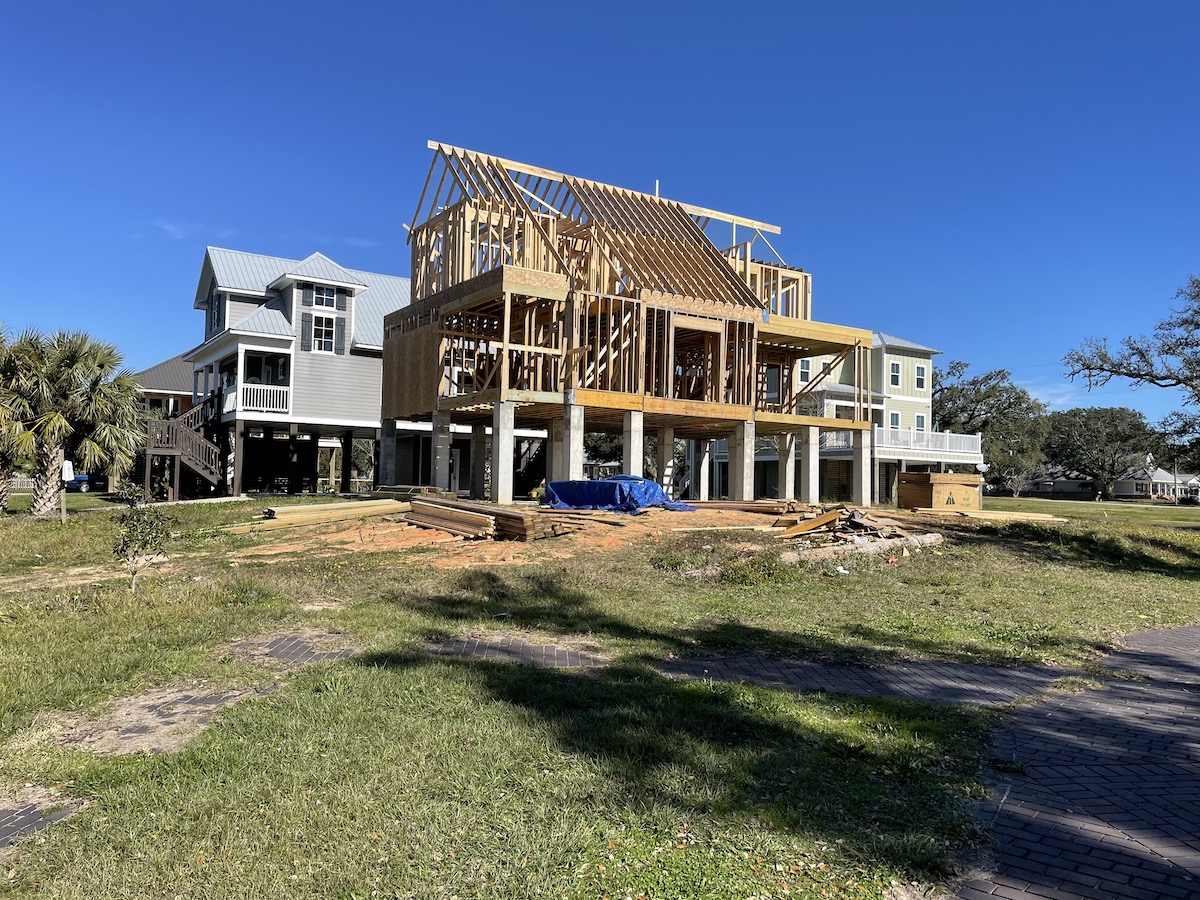Last updated on November 24th, 2022 at 05:16 pm
Last Updated on November 24, 2022 by
Building your own dream home may seem to be a difficult task but it is not. When you build your own perfect home, you get exactly what you want. New construction is a great option when you can’t find an existing house that meets your needs. Consider your own home, designed by you for you. You start by finding a great lot, exactly where you want to live. We are going to lead you through the process right here by explaining 5 important steps to build your own house now.
I am not recommending that you act as your general contractor. Acting as your contractor is another way to build a house which is a completely different discussion. This article will focus on using a licensed general contractor working with an architect. Experienced builders know how to get the job done right.
5 Important steps
The key steps outlined below are a starting point. Read the balance of the article to see how the pieces come together:
- Real estate Agent – Start the process by selecting a real estate agent in the area you consider the perfect location for your new house. Your real estate agent will become your partner in the process. Assuming you have selected one with experience in new builds, that person will help you with various aspects such as recommending a builder and others.
- Your lender – The article below will explain all of the details of the various loans that make up the entire project. Before you can decide on the size of the house you want, you need to create a budget. This must be done after receiving a pre-qualification from your lender. The lender you select should have expertise in new house construction. When you have your pre-qualification in hand you can move forward to the next step.
- Builder/General Contractor – Your real estate agent can be a great resource to help you select a builder. The builder you select will then help you with the next step which is finding a great lot to build your dream house on.
- The lot – You need to consider the type and size of house you want when selecting the lot to build on. There is a balancing act, the house must fit on the lot within the local building rules. You may want to build on the beach. The elevation of the house, position on the lot, etc. are part of the process. You may find a great lot but local regulations will not permit a house design you have been considering. This is one reason why selecting a real estate agent and builder before this step is important.
- Architect – Selecting a good architect is not difficult, just ask your builder and/or real estate agent to recommend one. Many builders work closely with local architects which can be a benefit. You will spend hours deciding on various aspects of the house with the architect. This person can work with the builder to insure the house you want will work on the lot you select and within local ordinances.
The above are the five important steps to build your house now. Within each of the steps above are many sub-steps. The process need not be difficult and can for many be a wonderful experience. Creating something from nothing and you were a participant. Your ideas, your creation. The remainder of this article will help you explore all of the steps to build your house and more.
Using a home builder who comes highly recommended is where we are going in this article. Selecting a good builder is one of the five important steps to building your own house now.
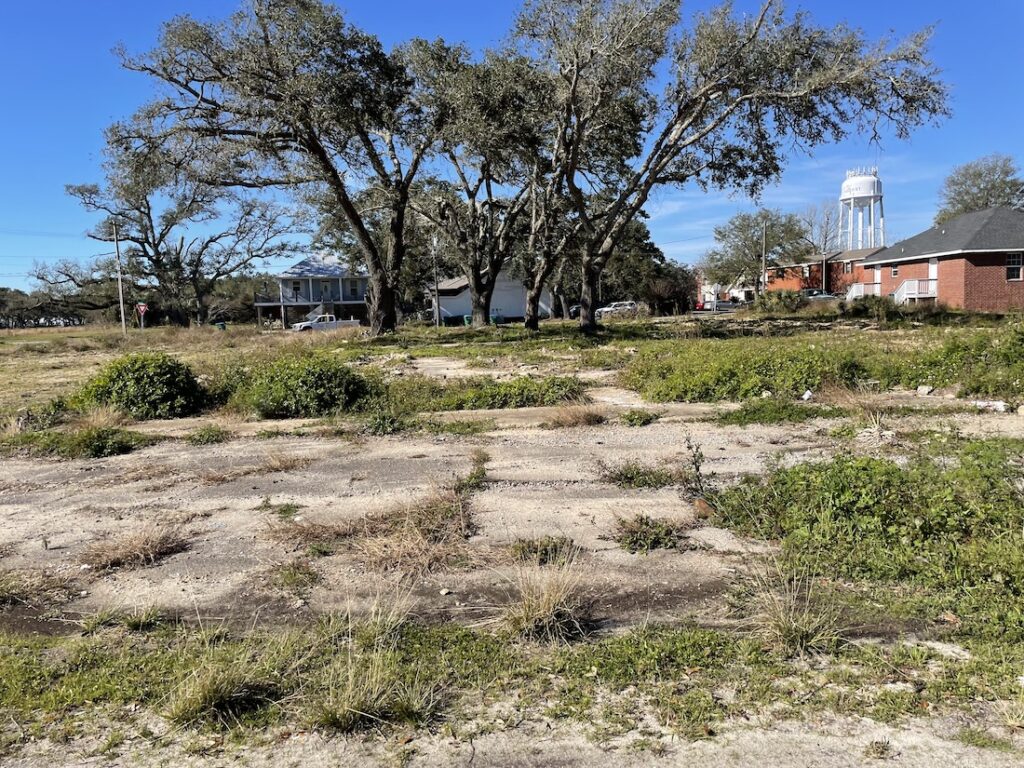
Where do you want to build your house?
Let’s start with where you want to build the house. Perhaps you are living in Minnesota and have decided it’s time to leave the snow and cold winters for beach living. I will use the Mississippi Gulf Coast as an example of a place to thaw out. You took a trip to Gulfport years ago to have fun at the casinos. There were many lots near the beach that had been cleaned of houses from a large hurricane many years before. You thought this may be a good place to live.
The next step is to contact a real estate agent in the local area such as Bill Anderson with Logan-Anderson Gulf Coastal Realtors. You explained where you think you may want to live. The next question is how many square feet for the house. This is important because there are zoning rules about setbacks (how far the house is from the property line). At this point, you have not given much thought to that question so you decide to think about it and call back.
This is the stage where you start thinking of the square footage of your house including bedrooms and bathrooms. The footprint of the house has to fit on the lot leaving room for the driveway and parking. I will get into this more as we get into the details of the project. Matching lot and house is one step in this process, the other is making sure your plot of land is zoned for single-family homes.
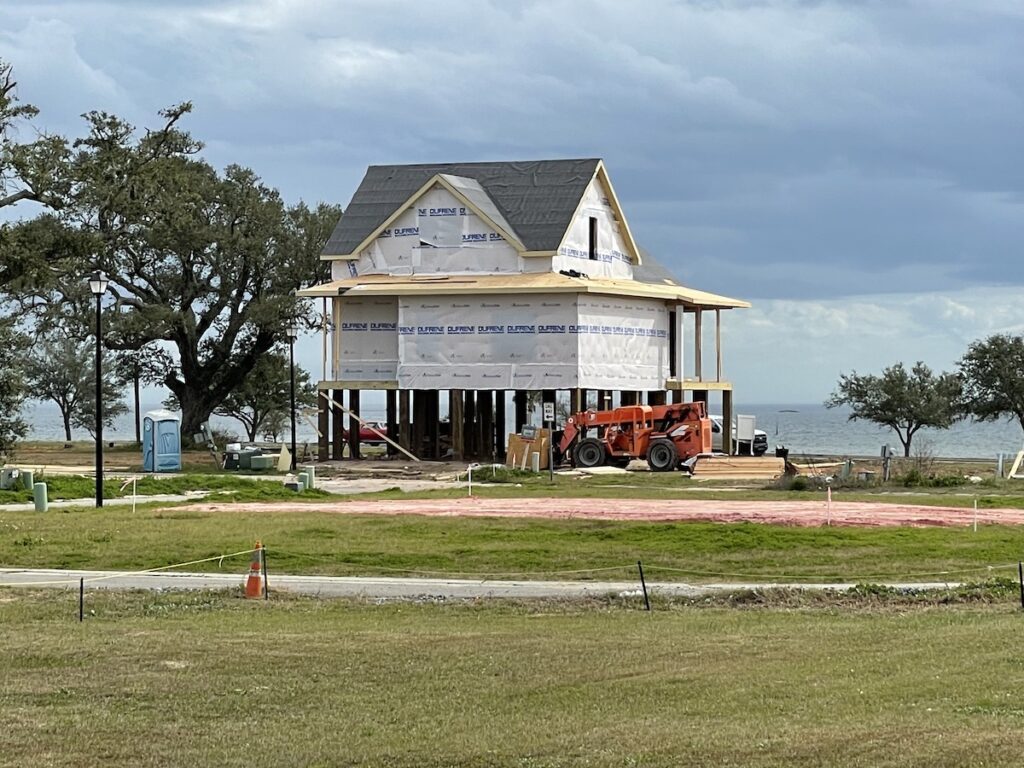
Choose a style, such as a slab or elevated
Another element is the style of the home, will it be constructed on a concrete slab or will it be elevated? The local authority may have restrictions on the type of home e.g. must be elevated 20 feet.
Your real estate agent will advise you of the general parameters for the selected lot e.g. it is zoned properly for what you want to build. Some people find the lot and want as many houses on that lot as the building permits would allow. Some buy a larger lot and want space for a garden and swimming pool so the house footprint is smaller.
Once the lot and house footprint are determined to match up, it’s time for the home buyers (you) to meet with a contractor and architect.
The house plans will be drawn based on your consultation with the architect and the builder. This is just the beginning. Your new house will start to appear on paper and that is when things get exciting. Before I go on, it’s time to back up a little. At this point, if not before, you should have discussed the cost of land with your real estate agent. Assuming you are going to build, you need to buy the land before investing in the plans and engagement of the architect and builder.
Most new home builds start with a 20% deposit (usually)
A real estate agent knows how to help you make an offer on the land. Most people buy the land with cash although you can finance it. Considering that many houses are built with a 20% down payment, the cost of the land is usually used as your contribution to the final mortgage loan. I will discuss this in more detail later. After the land is acquired, you can move forward with the details of the cost of the building.
Here is where the process requires your greatest attention. Every item you add to the plans will have an impact on building costs and labor costs. The construction process will proceed based on what you have decided to include in the plans. Your contractor will discuss the building process after the plans are completed. Back to those plans.
You have told the architect that you want a four bedroom, two and one half bathroom house. The living room is the center piece so you want it large and open to the kitchen. You want a door off of the living area into a deck (this house is going to be elevated because it is near the beach). The building plans will start to take shape as you decide where to place interior walls and the home of your dreams comes together.
The planning stage where you become an expert
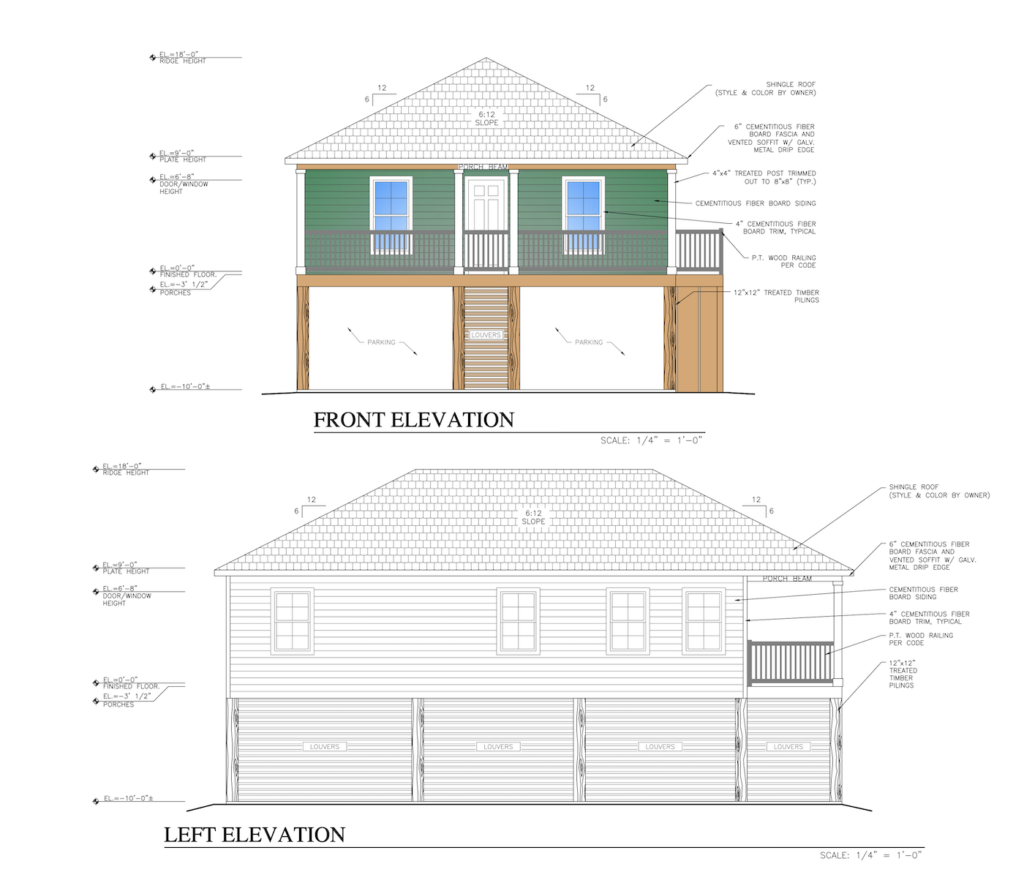
There are lots of things to consider and your contractor will walk you through the items that require any changes to the plans.
As the process unfolds, you may want a larger house and major changes will be made to your plans. The good news is that this is the planning stage and your first draft will not be your last. By the time you go through this process, you will become an expert on the process. You will learn there may be a better option for one choice over another.
The more you add, the greater the complexity of the project, and the higher the price. This part of the process is back and forth until you have a set of construction plans in your hand all signed off.
Now that the basic plans are complete, it’s time to discuss interior finishes, paint colors, and appliances. All of those things that go inside the house will be installed by the contractor as part of the purchase price. When you have finished this discussion, the builder will provide you with a final price.

You need three loans if you are financing the land
At this point in the process, you will need to obtain two or three loans if you are financing the project. Your mortgage broker will lay this out for you and take care of the process. A great mortgage broker will make the process seem similar to applying for a single loan.
- Loan #1 – Land purchase loan. You can finance the purchase of land only.
- Loan #2 – Construction loan. This loan pays the builder to build the house
- Loan #3 – Final mortgage loan. This is your 15-30 year loan for the finished house
The first loan is for the piece of land assuming you have not paid cash for it and decided to finance it. The land purchase is necessary before the project can go forward for obvious reasons, you can’t build on someone else’s property. When you close on the land, you will receive a trust deed which must be placed as collateral against the second loan.
The second loan is to cover construction costs. Funds are set aside by the lender for the contractor to draw against each phase of the project. This system works well because the contractor receives funds from the construction loan only when they have completed phase X. The next phase will earn the contractor another payment until the house is complete. Logan-Anderson will video the entire process for our out-of-town clients. Each week during the process, more video is added to an ever-expanding complete presentation.
When the new home build is complete and the local planning and building department is signed off, you will receive an occupancy permit which means you can move in. Before you rush into the house, you must close on the final loan which is the permanent mortgage loan. This last loan pays off the first two loans consolidating both the land and building into one. You will receive a trust deed on the final house at closing.
Communication is very important

What I have described above is the basic process and it should go well as long as everyone is communicating. Frequent communication between real estate agents, builders, lenders, and buyers is very important. The best way to avoid misunderstandings is to be sure everyone is following the basic plan. Home building need not be complicated. Yes, there are many details to discuss along the way such as electrical wiring, building materials, design features, and even the need for better insulation.
It is possible that changes can be made to the basic plan which may or may not require additional funding. You need to understand that the existing structure can not be rebuilt without higher costs and perhaps these may exceed the mortgage lenders” approval for your loan. It would help if you did not try to make changes after the process has reached certain cut-off stages. This is the key reason why good communication is essential.
I contracted to have a house built years ago. The contractor did good work, I checked on it constantly. One day I arrived to find a fiberglass bath/shower unit installed on the second floor. After they installed it, they framed it around it. The problem is that I contracted for a tile shower only. Somehow the plans got mixed up with another project and I was the one who caught it.
The builder had to remove the bath unit
Fortunately, it only set them back two days. They had to tear out the framing, remove the bath and bring in a tile setter. The builder had no problem fixing the issue. Fortunately, I was there to spot it. If the house had gone a week longer, it would have been extremely difficult to make the change.
Further to this story. The house had a high hip roof so there was lots of room on the second floor for a much higher ceiling. I told the contractor that I wanted the ceiling raised to the roof, and he agreed it would be a good look. On another drive-by, I noticed drywall with 9′ ceilings. Once again the contractor had to make it right, tearing out the drywall and framing, and moving the ceiling up another five feet.
Ok, my last mention of this story. We had contracted for a 20′ deck off of the dining room in the back of the house. There was to be a French door there leading out to a pleasant deck overlooking the yard and volcano (Vancouver, WA). The deck was to be the last thing added before the project was finished. We showed up for the walk-through and found that the deck stretched the entire length of the hose some 45′.
I paid for a 20′ deck and received a 45′ deck
My wife and I laughed. I did not have the heart to say anything to the builder. I only paid for 20′. The house closed and we moved in. During the year we lived here, not one thing went wrong. A good builder who needed constant communication to keep on target.
Building a house is the only way to get exactly what you want. I say exactly but what I mean is that you get basically what you want. Sometimes you may want something in the planning process but find that it either is more expensive or impractical. Perhaps your building site is not suited for a garage that faces North, the planning department may want it to face South.
Several factors can preclude you from obtaining exactly what you want. On the other hand, you will end up with what you have decided will work for you. That is much better than buying a house that requires work or does not suit your needs.
New technology helps in a special hazard area

If you live in a special hazard area such as along a beach, newly built homes will meet the latest requirements for such things as roof wind speed. I was looking at a new build the other day and the company representative told me that the roof was rated for 160 mph winds. This is much better than the older roofs rated for 120 mph or even a little newer at 140 mph.
New home construction standards continue to evolve and science discovers better materials. A focus on energy efficiency is a key reason to build or buy a new home. Saving money on electricity and natural gas because the latest construction method for windows was employed in your house.
Having discussed the process above for your own custom home, let’s talk about the average time it takes to build a new house. A spec home takes time to build because the materials for your house are unique to you. Your builder is not buying truckloads of roof trusses, they are only ordering what you need for your house. The same is true for all other materials e.g. windows.
Build time from break ground until keys are given – six months
Sometimes the builder can pick up materials locally as needed. Other times the materials must be ordered. The subcontractors must be scheduled with sufficient time between trades to include inspections. There may be a delay due to a lack of a subcontractor’s time or waiting for material. Sometimes local government can’t get inspectors out to meet the builder’s schedule.
Good builders understand the entire process and will give you an estimated completion date factoring in some delays. Your builder can not factor natural disasters into the schedule but almost everything else that can happen is probably built in. I use six months from the time the contract is signed with the builder to the time you have the keys as an average build time. If this is your first time building a new home, you must be patient. That constant communication I mentioned will help ease your anxiety about when the house will be finished.
One of the things that I like about building a new home, and I have repeated this process, is the little things. As an example, the house that I live in now was new construction. It was finished before I bought it. But, the designer was sharp. Just outside of my front door near the garage is a small garden. A water spigot is located on the wall above the small garden. They installed spigots on both sides of my house as well. One year after my house was finished the same builder built the “same” house model next door. There was no water spigot near the garden. Someone went through the plans and began removing what they thought were needless extras.
Consider the details such as rain gutters
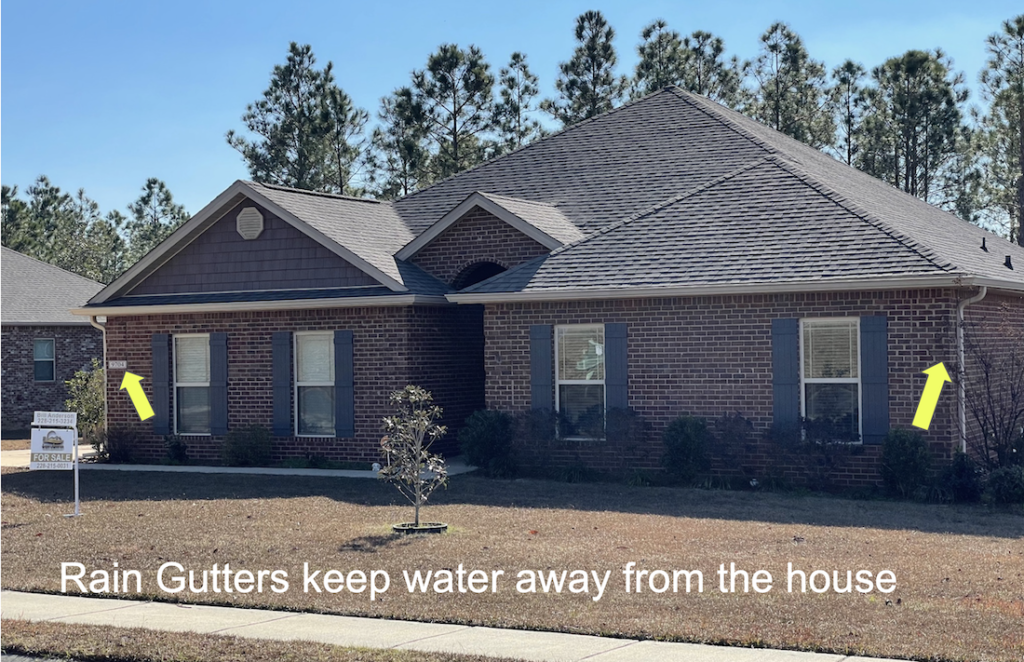
When the house next door sold the neighbor told me he could not water the front of his house because they only had two side spigots. This is what I mean. I would have requested a spigot If I were designing the house. Most homes in my area do not come with rain gutters. This is a mistake. In an area with lots of rain and termites, you need rain gutters to remove water from around the base of the house.
Not only will the water running off the roof erode the soil, but it will also saturate the soil near the house making it a potential breeding ground for termites. You can specify rain gutters as part of the house-building process.
Homeowners can modify their homes at any time in the future such as by adding rain gutters but these are modifications to the house. There is nothing better than to have things added to your house as part of the building process. They will be more reliable and less costly and best yet, they are financed for 30 years. Start with your simple design and make sure that anything you may want to add in the future is added at the start.
That traditional mortgage will allow you to push the cost out for 30 years. Also, if you sell your house after you just installed rain gutters, that money does not come back to you. If you finance it at the selling price you save the out-of-pocket cost.
Work with a talented real estate agent
You will need a loan as mentioned above. Not all banks and credit unions or online financial companies deal in new construction loans. If you do not have a relationship with a lender, ask your contractor. Try to work with someone who understands the process. Not just the company but the loan processor. Remember there are several loans and they can make the entire process almost seamless for you.

If your next home may be a house you build, the first step is to contact a real estate agent and find that ideal lot. You need not build immediately. Some people buy a lot and build it years later. Lots like most another real estate will appreciate. This means that buying it now is better than buying it later. Some obtain personal loans just to buy the lot and you are not obligated to build.
Of course, it depends on the land costs relative to your resources. The lot is generally a small portion of the cost of the project. For example, I recently sold a lot for $80,000 to a client who is building a house on it. The total project cost is about $445,000 so that makes the lot about 18% of the cost of the project.
Property taxes on vacant land are very reasonable so you should be able to hold on to the land for some time while you are working on your house plans. You may decide to put off building for some reason. The carrying costs will include your mortgage payment if you financed it plus a few hundred dollars per year for property taxes. You may want to consider hiring someone to cut the grass or weeds during the summer. Buying a liability insurance policy is also a good idea if there are other houses nearby such as the photo below.
Buy the land first and use it as collateral
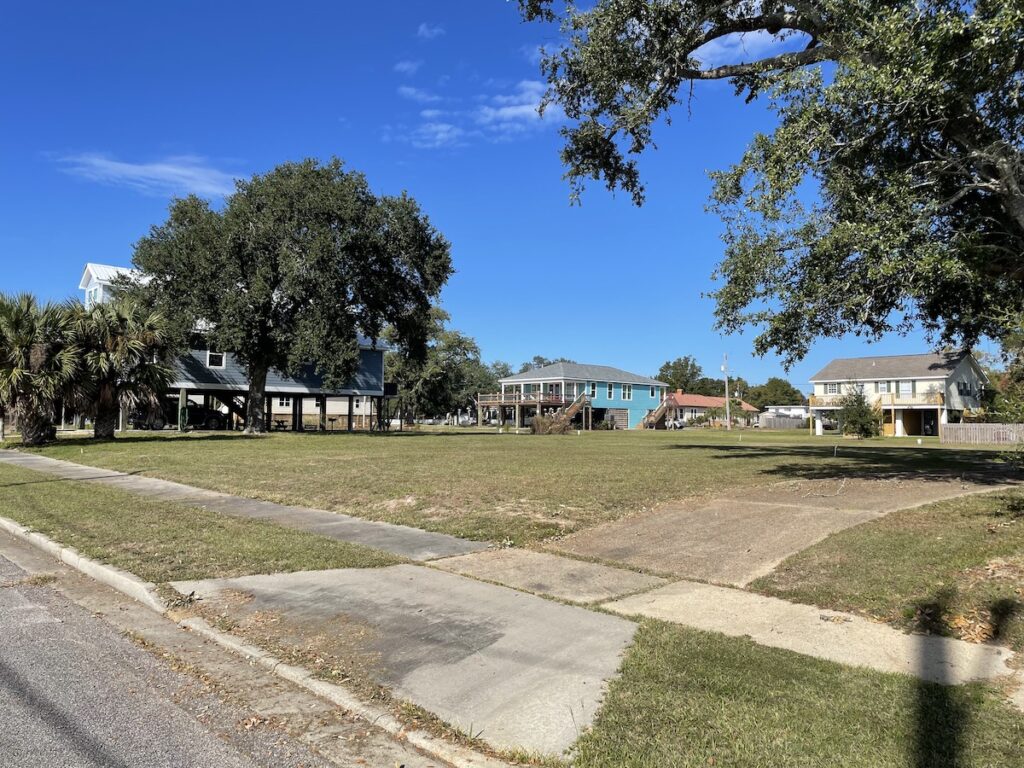
Remember when I said that most of these projects require 20% down (this is not set in stone)? Your investment in the lot when you first purchased it almost equals the required 20% down. If you wait for a while before you build, that lot may increase in value to a full 20% of the value of the project. Of course, you have to consider the increase in building materials and labor as well. My point is that the land is used as collateral with the lender so in most cases you may not be required to make a down payment. Your choice, pay cash or finance the land.
You should find that the interest rate for your loan will compare favorably with the rate paid to buy an existing house. With good a credit score and your debt-to-income ratios meeting the requirements, obtaining a loan to build a house should be no more effort than buying an existing house. The lender will need a copy of the house plans and your contract with the builder.
They may need additional information from the builder which they will obtain. An appraisal may be ordered for the project. While there is no general rule about the appraised value, I have seen that most projects will pass the lender’s appraisal requirements. You can not take this for granted, they may want to make changes to the house plans or the loan provisions.
Insurance rates favor new houses
Another advantage of building a new home or buying a newly built home is the cost of insurance. Should you live in a special hazard area, new houses are built to current standards for wind, hail, drainage, etc. Insurance companies will give their best rates for a new house. Insurance companies in recent years have begun to raise their rates for homes with older roofs.
I have a good example. A house that I purchased as a vacation rental started two years with an annual rate of $1,800. This included wind and hail plus homeowners, fire, etc. The cost went up to about $2,400 last year and this year it went to $4,100. My roof is now 15 years old, outside their 10-year window where rates start to rise.
Also, the roof while in great condition is probably a 120 mph roof and not the 160+ mph roofs being installed on new houses. The house is older which also causes rates to increase. Your new house with a new roof will receive a good insurance rate for many years, about 10 or more before the rates start to increase.
Consider that if I had purchased a new house using the example above, I would have saved about $23,000 for 10 years before my house rates would have met my existing rates. Most people are completely unaware of the impact that higher insurance rates have on their monthly payments or the effect they have on the debt-to-income ratios.
RESOURCES
Thank you for reading this article. There are more articles about real estate on our blog. Listen to our podcasts also. The following is a list of articles that may help you understand some of the elements listed in this article. A whole series has been created to help Millenials learn about finance and property. These articles are great for anyone looking to buy, build, finance, obtain insurance, and more.
17 things Millennials need now for their new dream home
Millennials: how to find your first house in 2023
The best mortgage loan guide for Millennials: start now 2023
The Homeowner’s Insurance Puzzle Made Simple for Millennials 2023
23 Easy ways Millennials can improve their credit scores:2023
Millennials are buying homes near the beach: Buy yours now
